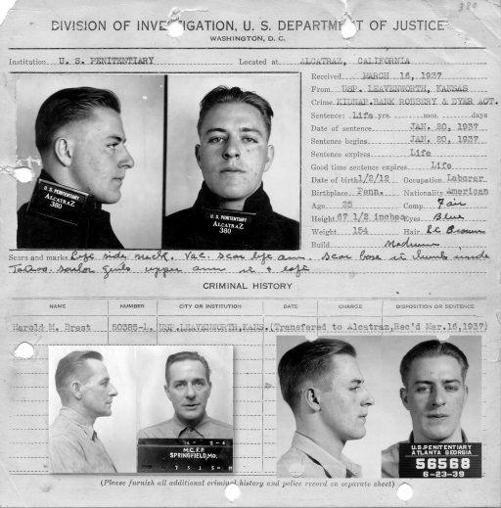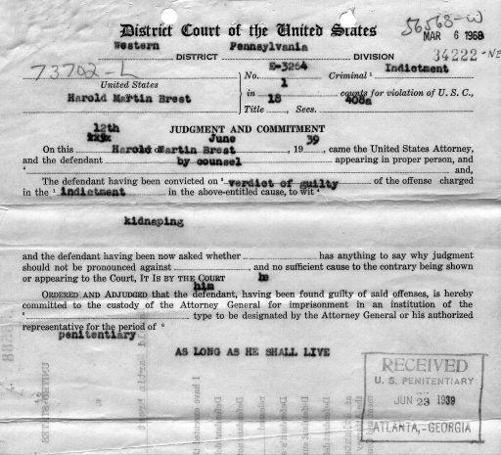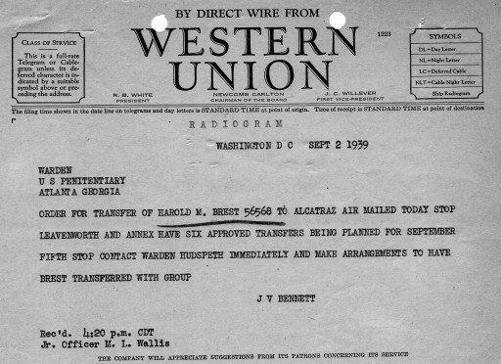Another report in his central file offered details of his violent tendencies:
Deputy Taff states that while crossing a bridge or large culvert on Highway #71, two miles north of Plat City, this prisoner suddenly tried to wreck the car by raising both feet and kicking against the back of the driver’s seat throwing the guard, who was driving at the time, against the steering wheel. The guard happened to be a man of large stature, and while thrown against the steering wheel he did not lose absolute control of the car although the incident did cause the car to leave the highway. Boarman likewise made an attempt to get the deputy’s revolver but was unsuccessful.
In view of this subjects traits in the instant offense if vicious nature, his previous institutional adjustments during confinement in the Federal Reformatory at El Reno, and the Federal Prison at Lewisburg, his present indifferent attitude and the indication that his future adjustment in confinement here or elsewhere is very definitely problematical. It is believed advisable that he be CONSIDERED FOR TRANSFER TO THE FEDERAL PRISON AT ALCATRAZ ISLAND, CALIFORNIA.
Harold M. Brest


Harold M. Brest was another inmate who would serve two separate terms at Alcatraz, under two separate register numbers.
Harold Martin Brest would be one of the few select inmates to be committed to Alcatraz twice during their lifetime. Born on January 2, 1913, Harold was the third in a family of six children, and he was reared in what was considered a good home environment in Sharon, Pennsylvania. Brest and his family suffered the loss of his mother when he was only seven years of age. His father was a skilled laborer, and struggled to raise his children in a “congenial atmosphere.” Early prison reports reflect an angry tempered individual with little restraint in his dealings with fellow inmates and correctional staff. Brest was originally sentenced in June of 1939 to serve two twenty-five-year sentences, one five-year sentence, and a life sentence for kidnapping and bank robbery.


A telegram authorizing Brest’s transfer to Alcatraz.
Brest’s criminal history is fully described in his Alcatraz inmate file:
At the age of 15, the subject first became a delinquent serving a 5-day jail term for trespassing. The following year he served a 10-day jail sentence, and in 1932 he received a one-year probation term in his hometown for larceny of auto. Again in 1933 he went to the State Prison, at Pittsburgh, PA., to serve a three to six year term for blackmail. The Parole Director of this institution advises this man while incarcerated there received a disciplinary report for being implicated with another inmate in an attack on an officer and suspected of degeneracy, and was held six months over the minimum sentence. He was paroled in 1936, and in January of 1937, less than a year later, he was sentenced to a term of life and 55 years concurrently for Kidnapping, Bank Robbery, and Dyer Act, and committed to Leavenworth Penitentiary, later being transferred to Alcatraz in March of 1937.
The circumstances of this crime are revolting and are outlined in detail in the Deputy Warden’s abstract of admission summary prepared at Leavenworth, copy of which is in the record.
Harold Martin Brest was indicted, in one count, with Harry James Logan, by the Federal Grand Jury at Erie, Pennsylvania, on September 24, 1936 for seizing, kidnapping, and carrying away one Deloria Lester Santee, for the purpose of robbing him of his money and his automobile, and by causing him to be transported by means of his automobile, by threats, by force and arms, against his will, from Sharon, Pennsylvania, to Youngstown, Ohio, on or about July 2, 1936.
On January 14, 1937, Brest and Logan were indicted by the United States Grand Jury, at Pittsburgh, Pennsylvania, charged in four counts, first, with taking from the person and presence of P.M. Cox, Cashier, and Mrs. Mabel Simpson Brown, Assistant Cashier, L.P. Hauschild and L.W. Morgan, National Bank Examiners, on September 15, 1936, lawful money of the United States, in the sum of $5,846.50, which money belonged to and was in the care and custody of the First National Bank of Volant, Pennsylvania; second, with perpetrating the said offense by the use of dangerous weapons and devices, two revolvers or pistols; third, with the robbery of the same bank on December 18, 1936, in the sum of $3,910.36, and fourth, with the use of dangerous weapons and devices in the perpetration of this robbery, to wit, two automatic pistols.
Brest further admitted that he, with Logan, on September 10, 1936, robbed the Farmer’s State Bank of Spring Green, Plain Station, Plain, Wisconsin, where by the use of arms and threats to kill the Cashier, he obtained, a little over $300.00. Brest stated that the banker was “Scared to death, white as a sheet and almost dropped dead;” and that he, Brest, cocked his gun, ready to shoot the banker if he asserted himself, or resisted in any way; that but for the fact that Logan became uneasy, Brest stated he would more than likely have killed this banker.
In addition, thereto Brest admitted that he and Logan participated in so many robberies of drug stores, filling stations, and the like in the states of Pennsylvania, Ohio, Illinois, Michigan, Wisconsin, and Minnesota, that it would be impossible for him to recall all of them. On being informed by an... B.I. Agent that he, Brest, entered the Volant National Bank but fifteen minutes prior to Pennsylvania State Policeman and that he probably would have been killed had they met there, Brest boldly said: “That all depends on who would have got the first shots in”.
On or about July 25, 1936, Logan and Brest while seated in an auto at a point near Zeeland, Michigan, they were observed by an officer, who gave chase, and caught up with them in Holland Michigan. While the officer drove up beside the car, Brest drew fourth his gun and shot the officer in the mouth. This officer, for a time, was not expected to live. However, the bullet was removed from the base of the officer’s skull and he is on the way to recovery. In conversing with the... B.I. Agent, Brest readily stated that he would shoot it out with any officer who attempted to apprehend him, and that had it not been for the fact that he was unarmed at the time of his arrest, which, incidentally, was the only time he went unarmed, in Boise, Idaho, he would have probably have shot and killed both policeman who apprehended him. During the conversation Brest at one time expressed regret that the shooting of the Police Officer did not result fatally.
Following transfer to Alcatraz, where he was sent for safer custody, he received three disciplinary reports; one on May 23, 1937 for creating confusion at the mess table; and two on September 20, 1937, for participating in a strike and refusing to go to work, and for agitating, creating a disturbance, and insolence to an officer and also for threatening an officer, agitating and causing a disturbance. On this date, after being placed in solitary, inmate told the Deputy Warden: “If I am ever turned out of solitary, I am going to kill you the first time you turn your back. I have killed men before and I would enjoy killing you.” It is clear from subject’s past criminal record and adjustment that notwithstanding his age, he is a confirmed criminal type with vicious and dangerous traits, impulsive and apparently devoid of any moral or social restraints.